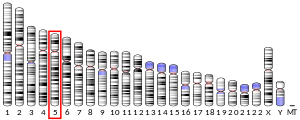ANKHD1
Ankyrin repeat and KH domain-containing protein 1 is a protein that in humans is encoded by the ANKHD1 gene.[4][5][6][7]
| ANKHD1 | |||||||||||||||||||||||||
|---|---|---|---|---|---|---|---|---|---|---|---|---|---|---|---|---|---|---|---|---|---|---|---|---|---|
| Identifiers | |||||||||||||||||||||||||
| Aliases | ANKHD1, MASK, VBARP, MASK1, PP2500, ankyrin repeat and KH domain containing 1 | ||||||||||||||||||||||||
| External IDs | OMIM: 610500 MGI: 1921733 HomoloGene: 87006 GeneCards: ANKHD1 | ||||||||||||||||||||||||
| |||||||||||||||||||||||||
| |||||||||||||||||||||||||
| Orthologs | |||||||||||||||||||||||||
| Species | Human | Mouse | |||||||||||||||||||||||
| Entrez | |||||||||||||||||||||||||
| Ensembl |
| ||||||||||||||||||||||||
| UniProt |
| ||||||||||||||||||||||||
| RefSeq (mRNA) | |||||||||||||||||||||||||
| RefSeq (protein) |
| ||||||||||||||||||||||||
| Location (UCSC) | Chr 5: 140.4 – 140.54 Mb | n/a | |||||||||||||||||||||||
| PubMed search | [2] | [3] | |||||||||||||||||||||||
| Wikidata | |||||||||||||||||||||||||
| |||||||||||||||||||||||||
Function
This gene encodes a protein with multiple ankyrin repeat domains and a single KH domain. Co-transcription of this gene and the neighboring downstream gene (EIF4EBP3) generates a transcript (MASK-BP3) which encodes a fusion protein composed of the MASK protein sequence for the majority of the protein and a different C-terminus due to an alternate reading frame for the EIF4EBP3 segments.[7]
gollark: 64k *fluid* cells? That's so useless.
gollark: Probably due to the lack of tooling for producing them on-demand.
gollark: Fluids are, for some weird coincidental reason, mostly produced in bulk.
gollark: Why would they not?!
gollark: Also, use P2P for moar channels.
References
- GRCh38: Ensembl release 89: ENSG00000131503 - Ensembl, May 2017
- "Human PubMed Reference:". National Center for Biotechnology Information, U.S. National Library of Medicine.
- "Mouse PubMed Reference:". National Center for Biotechnology Information, U.S. National Library of Medicine.
- Kikuno R, Nagase T, Ishikawa K, Hirosawa M, Miyajima N, Tanaka A, Kotani H, Nomura N, Ohara O (Jun 1999). "Prediction of the coding sequences of unidentified human genes. XIV. The complete sequences of 100 new cDNA clones from brain which code for large proteins in vitro". DNA Research. 6 (3): 197–205. doi:10.1093/dnares/6.3.197. PMID 10470851.
- Wiemann S, Weil B, Wellenreuther R, Gassenhuber J, Glassl S, Ansorge W, Böcher M, Blöcker H, Bauersachs S, Blum H, Lauber J, Düsterhöft A, Beyer A, Köhrer K, Strack N, Mewes HW, Ottenwälder B, Obermaier B, Tampe J, Heubner D, Wambutt R, Korn B, Klein M, Poustka A (Mar 2001). "Toward a catalog of human genes and proteins: sequencing and analysis of 500 novel complete protein coding human cDNAs". Genome Research. 11 (3): 422–435. doi:10.1101/gr.GR1547R. PMC 311072. PMID 11230166.
- Miles MC, Janket ML, Wheeler ED, Chattopadhyay A, Majumder B, Dericco J, Schafer EA, Ayyavoo V (Aug 2005). "Molecular and functional characterization of a novel splice variant of ANKHD1 that lacks the KH domain and its role in cell survival and apoptosis". The FEBS Journal. 272 (16): 4091–4102. doi:10.1111/j.1742-4658.2005.04821.x. PMID 16098192.
- "Entrez Gene: ANKHD1 ankyrin repeat and KH domain containing 1".
External links
- Human ANKHD1 genome location and ANKHD1 gene details page in the UCSC Genome Browser.
Further reading
- Morris JA, Kandpal G, Ma L, Austin CP (Jul 2003). "DISC1 (Disrupted-In-Schizophrenia 1) is a centrosome-associated protein that interacts with MAP1A, MIPT3, ATF4/5 and NUDEL: regulation and loss of interaction with mutation". Human Molecular Genetics. 12 (13): 1591–1608. doi:10.1093/hmg/ddg162. PMID 12812986.
- Poulin F, Brueschke A, Sonenberg N (Dec 2003). "Gene fusion and overlapping reading frames in the mammalian genes for 4E-BP3 and MASK". The Journal of Biological Chemistry. 278 (52): 52290–52297. doi:10.1074/jbc.M310761200. PMID 14557257.
- Bouwmeester T, Bauch A, Ruffner H, Angrand PO, Bergamini G, Croughton K, Cruciat C, Eberhard D, Gagneur J, Ghidelli S, Hopf C, Huhse B, Mangano R, Michon AM, Schirle M, Schlegl J, Schwab M, Stein MA, Bauer A, Casari G, Drewes G, Gavin AC, Jackson DB, Joberty G, Neubauer G, Rick J, Kuster B, Superti-Furga G (Feb 2004). "A physical and functional map of the human TNF-alpha/NF-kappa B signal transduction pathway". Nature Cell Biology. 6 (2): 97–105. doi:10.1038/ncb1086. PMID 14743216.
- Lim J, Hao T, Shaw C, Patel AJ, Szabó G, Rual JF, Fisk CJ, Li N, Smolyar A, Hill DE, Barabási AL, Vidal M, Zoghbi HY (May 2006). "A protein-protein interaction network for human inherited ataxias and disorders of Purkinje cell degeneration". Cell. 125 (4): 801–814. doi:10.1016/j.cell.2006.03.032. PMID 16713569.
- Traina F, Favaro PM, Medina Sde S, Duarte Ada S, Winnischofer SM, Costa FF, Saad ST (Sep 2006). "ANKHD1, ankyrin repeat and KH domain containing 1, is overexpressed in acute leukemias and is associated with SHP2 in K562 cells". Biochimica et Biophysica Acta (BBA) - Molecular Basis of Disease. 1762 (9): 828–834. doi:10.1016/j.bbadis.2006.07.010. PMID 16956752.
This article is issued from Wikipedia. The text is licensed under Creative Commons - Attribution - Sharealike. Additional terms may apply for the media files.

